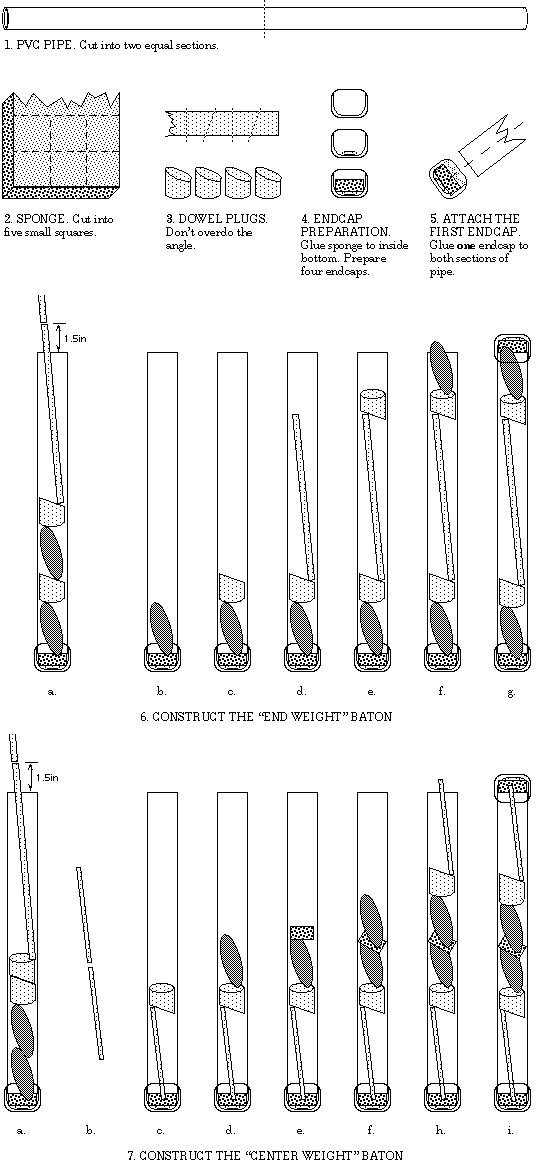MATERIALS
___ PVC pipe, 3/4in schedule 40 (about 5ft)
___ PVC endcaps, 3/4in (4) [anti-roll "nibs" are nice]
___ sponge or foam rubber (about 6in2)
___ wood dowel, 3/4in dia. (4in + enough to clamp)
___ wood dowel, 1/4in dia. (two 2ft lengths)
___ "torpedo" fishing weights, 6oz (4)
___ PVC cement
TOOLS
___ PVC cutters (for cutting PVC and thin dowel)
___ heavy-duty scissors (for cutting sponge)
___ hand saw (for cutting thick dowel)
___ table vise (or equivalent means for securing thick dowel for sawing)
CONSTRUCTION INSTRUCTIONS (You can find corresponding diagrams below)
1. Using PVC cutters, cut PVC pipe into two equal lengths: 30in lengths are good for bigger kids; 20in lengths might work better for smaller kids. The longer the bar, the more dramatic result. But batons too long for easy/safe student use should be avoided. You know your students better than I do; use your best judgment.
2. Using the heavy-duty scissors, cut sponge into 5 squares that will fit snugly into the endcaps. These will act as cushions to keep the bar's contents (weights and dowel) from rattling. One square will go between the weights in the "center weight" baton.
3. Using the hand saw, cut thick dowel into 1in plugs. Each plug has a flat end and a slightly angled end.
4. Prepare endcaps. Place some PVC cement on the inside bottom of an endcap. Place a sponge square in the endcap, "mashing" it into the glue. Repeat for the other three endcaps.
5. Apply PVC cement around the inner sidewall of the endcap and glue one endcap to a length of PVC pipe. Rotate the endcap slowly as you join it to the pipe for best results. Repeat this for the other bar. (Don't glue two encaps on the same empty pipe!)
6. Construct "end weight" bar.
a. Look at the diagram of the finished product (fig. 6.g.). The spacer dowel keeps the weights at the ends of the baton. The spacer's length must be such that when the all the contents are properly arranged, the top fishing weight pokes up out of the PVC pipe by about half an inch. To approximate, drop a fishing weight, then a dowel plug, then a second fishing weight and a second plug into the tube. Now insert the uncut spacer dowel. Using the PVC cutters, cut the spacer dowel about 1-1/2in above the top of the PVC pipe. Now remove all contents from the tube.
b. Drop one fishing weight into the tube.
c. Drop a dowel plug-angle side up-onto the fishing weight.
d. Insert the spacer dowel so that it wedges between the dowel plug and PVC pipe as shown in the diagram.
e. Add the second dowel plug, angle side down.
f. Add a second fishing weight on top of the dowel plug. Massage/jostle the tube contents until everything has settled as far as possible. (If they have not completely settled and you finish the tube off, it will rattle when used. This detracts a bit from the magic of the demonstration.)
g. With NO glue, check the fit of the top endcap. You should be able to press it onto the top fishing weight so that there is resistance from the fishing weight while there is also enough PVC pipe for the endcap to connect to. If the fishing weight keeps the endcap too far from the pipe, remove the weight and plug dowel and trim the spacer dowel back.
h. When the fit is right, glue the top endcap to the PVC pipe. Press and hold the endcap down while the glue sets.
7. Prepare "center weight" bar.
a. More art. Look at the diagram of the finished product (fig 7.i.). You need two roughly equal spacer dowels. Their length must be such that when the all the contents are properly arranged, the top of the top spacer dowel pokes up out of the PVC pipe by about the same height as the fishing weight did in the "end weights" bar. To approximate, drop two weights into the tube followed by two dowel plugs. Now insert the uncut spacer dowel. Using the PVC cutters, cut the spacer dowel about 1-1/2in above the top of the PVC pipe. Remove all contents and cut the useful length of spacer dowel in half.
b. When you've got two spacers of the correct length, drop one spacer into the tube.
c. Drop a dowel plug-angle side down-into the tube.
d. Drop a fishing weight into the tube.
e. Drop a sponge square into the tube. If it resists...
f. Add a fishing weight on top of the sponge.
g. Add a dowel plug, angle side up.
h. Add the second dowel spacer. Again, massage/jostle the tube contents until you think everything has settled as far as possible.
i. With NO glue, check the fit of the top endcap. You should be able to press it onto the top spacer so that there is resistance from the spacer while there is also enough PVC pipe for the endcap to connect to. If the spacer keeps the endcap too far from the pipe, trim the top spacer dowel back.
j. When the fit is right, glue the top endcap to the PVC pipe. As you fix the location of the top endcap, recall that a key feature of the Rotational Mystery Batons is that they appear to be completely identical: they should be of equal length. Press and hold the endcap down while the glue sets.
DIAGRAMS

Return to Mr. Baird's Phyz Home Page.